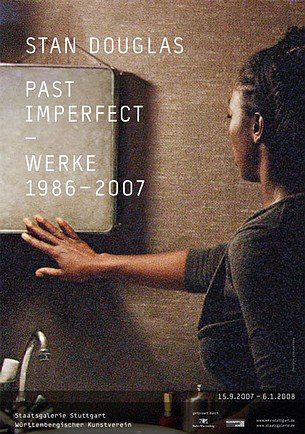13/9/2007
Stan Douglas
Two venues, Stuttgart
Past Imperfect - Works 1986 - 2007. The show displays fourteen video and film installations as well as more than 120 photographs. As no other artist, Douglas has expanded the experiential spaces of cinema, television, and the museum, both sensorially and intellectually. Time, the key material of his works in many respects, is detached from its familiar order to become a Past Imperfect: an imperfect process of that which has always been the past.

Past Imperfect
curated by Hans D. Christ, Iris Dressler
From September 15, 2007 to January 6, 2008, the Staatsgalerie Stuttgart and the Württembergischer Kunstverein are presenting the first comprehensive show of Canadian artist Stan Douglas’s work, with fourteen video and film installations as well as more than 120 photographs.
Stan Douglas, who was born in Vancouver in 1960, counts among the most important contemporary artists. He has taken part in the Documenta (1992, 1997, 2002) and the Venice Biennale (1990, 2001, 2005) three times and has also been represented at numerous other biennials. Major exhibition venues have devoted solo shows to him. However, it is in Stuttgart that his key works of the past twenty years will be presented for the first time in a single exhibition. Being held at two locations, the exhibition does not follow a chronological order but rather takes up different possible interpretations of this complex oeuvre.
As no other artist, Douglas has expanded the experiential spaces of cinema, television, and the museum, both sensorially and intellectually. Time, the key material of his works in many respects, is detached from its familiar order to become a Past Imperfect: an imperfect process of that which has always been the past.
Referring back to the intellectual, cultural, and ideological traditions of modernism, his works constitute a critical revision of Western history and contemporary times. It is the failure of modern utopias around which his works repeatedly revolve. All of his film and video installations are preceded by an analysis of a certain place—Potsdam, British Columbia, Havana, Detroit—on whose history Douglas reflects in reference to literary, filmic, or musical sources: for example, E.T.A. Hoffmann’s Der Sandmann, the Grimms’ Fairy Tales, Karl Marx’s Capital, Samuel Beckett’s Film, or Arnold Schönberg’s Begleitmusik zu einer Lichtspielscene. Often, Douglas changes the gender and the skin color of the protagonists that he borrows. Seemingly irreconcilable contexts are brought into relation and, thanks to the unique way in which Douglas appropriates audiovisual media, result in an open, ambiguous narrative.
The exhibition will be accompanied by a short guide (ca. 100 pages) as well as by a comprehensive catalogue (publishing date: October 2007, 224 pages) published by Hatje Cantz.
Opening: 14 September 2007
Artist’s Talk: 15 September, 1 pm
Press Contact
Yvonne Mielatz
Fon: +49 (0)711 - 22 33 721, Fax: +49 (0)711 - 29 36 17
mielatz@wkv-stuttgart.de
Venues:
Staatsgalerie Stuttgart
Konrad-Adenauer-Straße 30-32 - Stuttgart
Hours: Tue, Wed, Fri-Sun: 10 am - 6 pm; Thu: 10 am - 9 pm
Württembergischer Kunstverein Stuttgart
Schlossplatz 2 - Stuttgart
Hours: Tue, Fri-Sun: 11 am - 6 pm; Wed + Thu: 11 am - 9 pm



